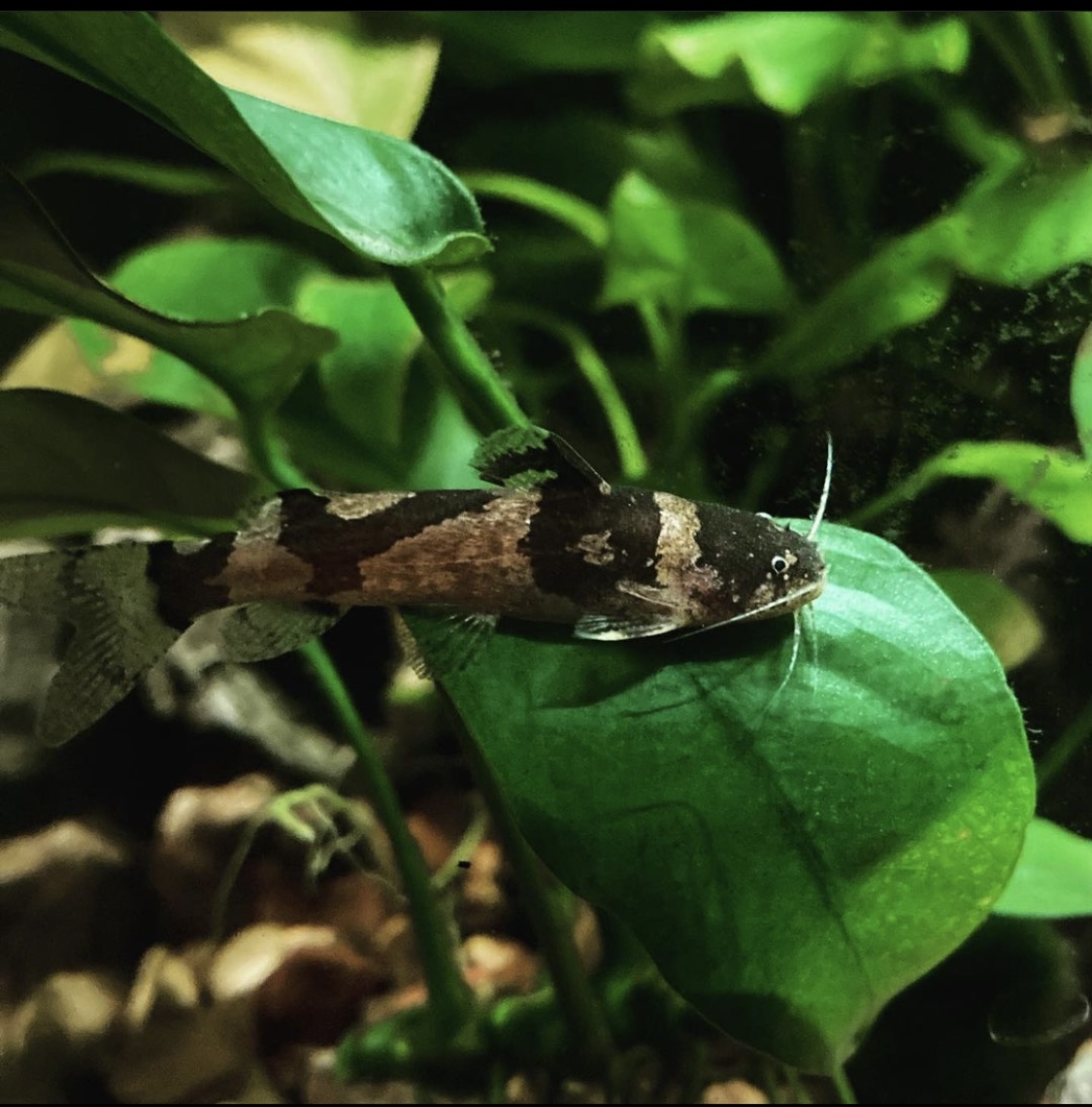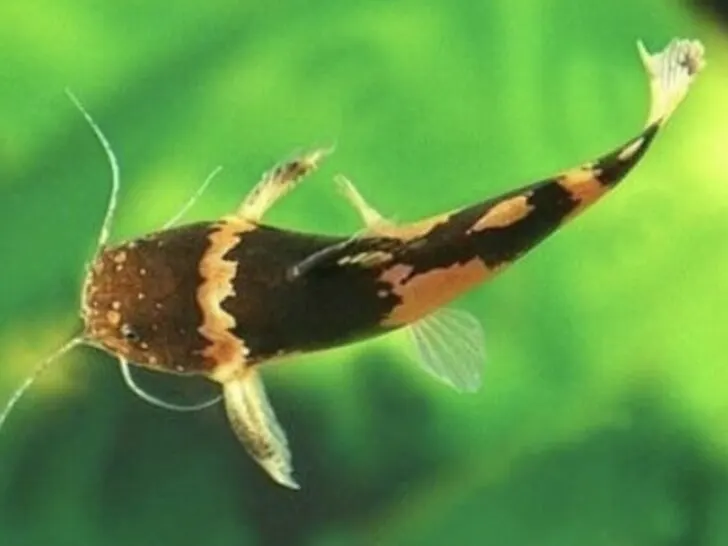
When considering what fish to add to your tropical tanks, you may find yourself captivated by the Bumblebee catfish and wonder what you need to know to care for one properly. These hardy, freshwater bottom-dwellers can be the perfect addition to a freshwater fish community.
Bumblebee catfish are nocturnal, shy freshwater fish from South America that are a popular species as pets. They are relatively easy to care for, and their bumble-bee like appearance draws the eye when they come out of their hiding spots after dark to look for food.
This article will cover everything you need to know about the South American Bumblebee catfish, from caring for them to setting up a tank that will let them thrive.
What Are Bumblebee Catfish?
As their name suggests, Bumblebee catfish (Microglanis ihering) are a medium-sized catfish species with coloring that resembles a bumblebee. They are labeled as ‘beginner-level’ fish but do have specific needs, such as calm tank mates.
When well cared for, these fish can live around four years, with reports of some reaching between six to ten years old.
It should be noted that while the South American Bumblebee catfish is generally the fish meant when aquarium keepers are discussing ‘Bumblebee catfish,’ there is another species with a similar appearance and name.
The Asian Bumblebee catfish (Pseudomystus siamensis) is not closely related to the South American species and is more aggressive.
Why Are Bumblebee Catfish Popular Freshwater Aquarium Fish?

It is not only the physical appearance of a Bumblebee catfish that makes it a popular choice for aquariums but its personality as well. Having been named in 1946, it took only three decades for this species to become a well-known ornamental pet fish.
Physical Appearance
A Bumblebee catfish’s long, rounded body shape is covered by a series of dark and dull yellow bands, like the insect it’s named after. The darker bands, which typically start at the first strip that covers the head, can be black or dark brown. They have wide mouths for sucking up food and can eat fish smaller than themselves.
These catfish are medium-sized for aquarium fish and can reach up to 3-3.5 inches (7.6-8.9 cm) in length, though around 2-2.5 inches (5.1–6.4 cm) is more common.
Their bellies are usually entirely dull yellow, though the stripes reach up to the impressive dorsal fin and continue from the head to the tail fin. Other than the spiny dorsal, the other fins are relatively tiny.
What Are Bumblebee Catfish ‘Whiskers’ For?
Like other catfish, Bumblebee catfish have ‘whiskers’ around their mouth. These protrusions are known as ‘barbels’ and help the fish sense their environment. These sensitive barbels work not only as a sense of touch but also to help the animals to find food.
Personality
Aside from their unique pattern, Bumblebee catfish are loved for their docile personality. They can live with other fish in a tank, and aggression from this species (as opposed to the Asian Bumblebee catfish) is rare.
If you see any signs of aggression from one of these catfish, the likely cause is not enough room in the tank in general or that you have multiple males and, again, insufficient space.
There is a downside to the Bumblebee catfish’s quiet personality, and that is that they are timid and easily spooked. You shouldn’t expect to see this fish out and about exploring the tank except when looking for food.
Natural Environment
In the wild, Bumblebee catfish can be found in fast-moving streams and rivers in Colombia and Venezuela, with smaller populations in Peru and Brazil. Their coloring and pattern help them camouflage against the rocky river bottom.
When Are Bumblebee Catfish Most Active?
While you may be used to seeing your tropical fish swimming around at all parts of the day, Bumblebee catfish are nocturnal. They come out at night after the lights have gone off, so it’s best to feed them before you go to bed and early in the morning.
It is possible to convince your Bumblebee catfish to come out during the day by offering food, but they won’t stay out for very long before swimming back to their favorite hiding spot. Dim lighting may make it easier to lure the fish out before nightfall.
Do Bumblebee Catfish Sleep?
If these fish are nocturnal, does that mean they sleep all day, like bats or hamsters? Perhaps. There are a lot of unknowns about fish sleep, though when they rest, they go into a state of ‘suspended animation.’ Yet, while they may huddle down in a secure spot or simply float while resting, fish are still alert to possible dangers.
How To Care for a Bumblebee Catfish
Bumblebee catfish are easy-to-care-for fish that are good for beginners and experts alike. Their water requirements and tank size are similar to what you would already expect a tropical freshwater fish to be, and a weekly change of about twenty-five percent of the water is recommended.
Tank Set-Up
At a minimum, you’ll need a twenty-gallon tank for a single Bumblebee catfish and at least ten more gallons per any additional ones (six is the maximum recommended number for this species in a single tank). The water needs to be on the soft side, with a pH between 6.5-7.5 and high oxygen levels.
These South American fish are used to warm waters, so the tank temperature should stay between 70-77 degrees Fahrenheit (21-25 degrees Celsius). A heater like the AquaMiracle Submersible Fish Tank Heater on Amazon with a readable thermostat is a good choice.
The substrate on the tank floor is another thing to pay attention to. Due to the Bumblebee catfish’s bottom-dwelling lifestyle and sensitive barbels, you’ll want a smooth, soft substrate for the tank.
There should be lots of smooth rocks and pebbles of various sizes. Ensure that any stones you find outside are thoroughly cleaned before putting them in the tank.
What To Place in the Tank
As fitting of their shy personalities, Bumblebee catfish need options for hiding places in their home. In the wild, they hide between rocks and under plants. Java ferns and other broad-leaved plants are good choices.
However, what Bumblebee catfish will really appreciate are some good caves or hollow logs to hunker down in. While these pieces may make it even harder to find your fish during the day, you can try to position the decor such that you can see directly into the hollow or via its reflection in the glass.
Diet
These fish are omnivores and as unfussy about their meals as the label suggests. They prefer live prey and will ambush potential meals in the wild. Some good choices for live food in captivity include bloodworms, brine shrimp, and insect larvae.
As catfish are bottom-feeders, make sure you get fish pellets that sink, like these Aqueon Shrimp Pellets for bottom-feeders.
While they will eat plant matter and vegetables, like lettuce and zucchini, Bumblebee catfish are not the type to eat natural algae. However, they will eat algae wafers.
Will a Bumblebee Catfish Eat Other Fish in the Tank?
An omnivore’s diet includes protein, and for catfish, that includes other fish. Small tropical species like tetras and guppies may be pretty additions to any freshwater tank, but not if you have a Bumblebee catfish. These catfish will eat fish smaller than them, as well as snails or shrimp.
Basically, if there’s any type of “food” that will fit in a Bumblebee catfish’s wide, stretchy, vacuum cleaner-like mouth, there’s a high chance they’ll eat it.
Where Can You Get a Bumblebee Catfish?
You likely won’t be able to find a South American Bumblebee catfish (or the Asian Bumblebee, for that matter) in your average pet store. They aren’t terribly expensive, but they can be hard to find. If you want one, your best bet is to look online for a reputable fish breeder or find an aquarium specialty store.
Can You Breed Your Own Bumblebee Catfish?
While some fish keepers enjoy breeding their fish, aiming for the perfect color or personality, Bumblebee catfish can’t be bred in captivity by the average person. There are two main reasons for this, and the first is that it’s hard to tell the sex of one of these fish. Males and females look practically the same.
The second reason captive breeding for this species is so difficult is that they require extremely specific conditions to breed in the wild. That goes for the type and amount of food they need to eat to breed and the overall environment. Breeders at fish farms or other facilities can replicate the conditions, but most Bumblebee catfish sold are wild-caught.
According to the International Union for Conservation of Nature’s Red List of Threatened Species (IUCM), the South American Bumblebee catfish was listed as ‘least concern’ as of 2020 but buying captive-breed fish when possible is still a better choice.
What Type of Fish Are Good Tankmates for a Bumblebee Catfish?
If Bumblebee catfish will eat tankmates smaller than them, then what types of fish can live in the same tank as them? Similarly-sized, community tropical fish are some of the best options to live alongside these catfish. Potential companions include Rainbow sharks, Dwarf Gouramis, and other catfish. Fish like Cichlids and Tiger Barbs are more in the gray area.
Size is not the only thing to take into consideration. Bumblebee catfish can be easily stressed if placed with high-activity, hyper fish. So not only do you want peaceful fish, but calm ones as well.
What Disease Can Bumblebee Catfish Get?
Even the hardiest animals can get sick, and Bumblebee catfish are no exception. Like almost all tropical fish, ich is the most common disease these fish can get. Ich is caused by single-celled parasites called Ichthyophthirius multifiliis, and has a high chance of being fatal when not treated quickly. Symptoms to watch for include:
- Scratching against items in the tank.
- Jumping out of the water.
- Raised white bumps on the skin or fins. Ich can affect the gills, but no bumps will form on them.
The good news is that ich is preventable and treatable, though that treatment will take at least five days. This article in TropicalFish Magazine goes into more detail about ich, but here are the main steps to take if any of your fish get infected:
- Quarantine the infected fish(s).
- Change the water in the quarantine tank frequently.
- Add salt and keep the water slightly warmer than usual in the quarantine tank.
You will also want to do as full of a tank clean for the main tank as well, and make sure previously infected fish are entirely recovered before returning them to their regular home.
How Smart Are Bumblebee Catfish?
Fish are much more intelligent than the average person gives them credit for, capable of spatial maps for navigation and remembering locations, social bonds, and even social learning and perhaps passing down information between generations.
Catfish are no exception, with one species in southwest France learning to lunge onto land to grab birds to eat, then wiggling back to the safety of the water, as described in this article in Smithsonian Magazine. But what about your average aquarium Bumblebee catfish?
Bumblebee catfish are smart and will learn to recognize their caretaker. As mentioned above, you can even teach them to come out for a short period of time during the day.
Conclusion
When considering whether to add a Bumblebee catfish to your tropical freshwater tank, consider their omnivorous diet and shy nature. Even after your fish learns to recognize you, you probably won’t see this nocturnal fish very often as they will spend most of the day between rocks or hiding spots like caves.
However, this South American fish’s beautiful bumblebee-like pattern and peaceful nature may be more than enough to tempt you, and while they might be hard to find at a pet store, you can plan on this hardy fish living for a good few years.

